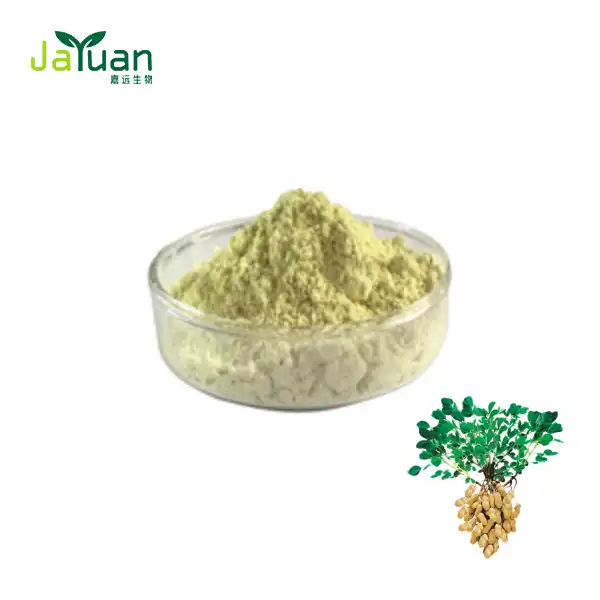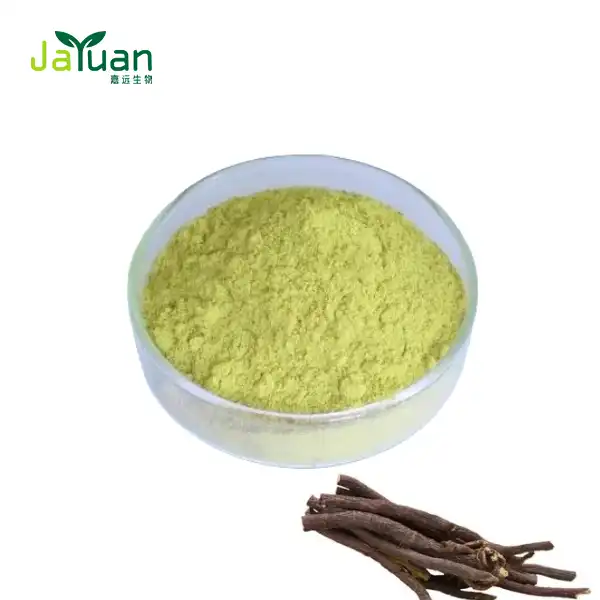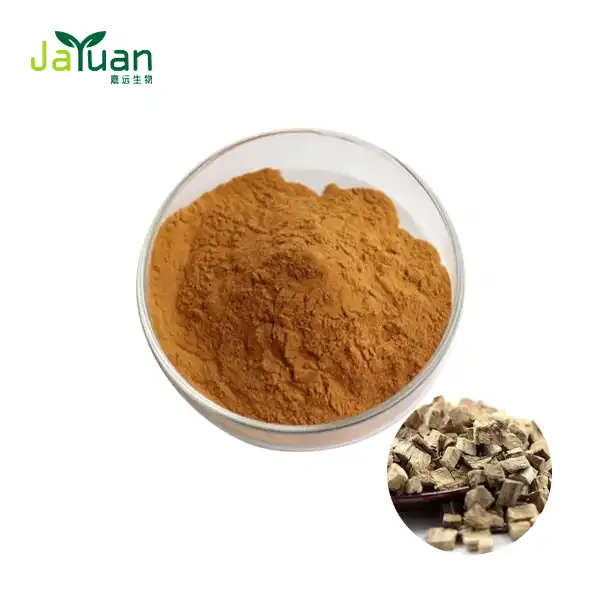How does Fibraurea recisa Pierre compare to other herbal extracts in treating skin conditions?
Fibraurea recisa Pierre, a plant with a rich history in traditional medicine, has garnered attention for its potential in treating various skin conditions. This article delves into the comparative efficacy of Fibraurea recisa Pierre extract against other popular herbal remedies for skin health, exploring its unique properties and mechanisms of action.

Overview of Fibraurea recisa Pierre: Traditional Uses and Benefits
Fibraurea recisa Pierre, commonly known as Huangteng, is a flowering plant species belonging to the Menispermaceae family. Native to certain regions of Southeast Asia, this plant has been a staple in traditional medicine systems for centuries. The extract derived from its dried stem, rich in bioactive compounds, has been used to address a variety of ailments, including skin disorders.
The primary active ingredient in Fibraurea recisa Pierre extract is palmatine, an isoquinoline alkaloid known for its potent biological activities. This compound, along with other phytochemicals present in the extract, contributes to its therapeutic potential in skincare applications.
Traditionally, Fibraurea recisa Pierre has been utilized for its anti-inflammatory, antimicrobial, and antioxidant properties. These attributes make it a promising candidate for treating various skin conditions, including:
- Acne and other bacterial skin infections
- Eczema and dermatitis
- Psoriasis
- Fungal skin infections
- Wound healing
The versatility of Fibraurea recisa Pierre extract in addressing multiple skin issues has piqued the interest of researchers and skincare formulators alike. Its potential to offer a natural, multi-faceted approach to skin health sets it apart from many single-action synthetic ingredients.
Comparative Analysis: Fibraurea recisa vs. Common Herbal Extracts
To understand the unique position of Fibraurea recisa Pierre extract in the realm of herbal skincare, it's crucial to compare its efficacy with other popular plant-based remedies. Let's examine how it stacks up against some well-known herbal extracts used in treating skin conditions:
Fibraurea recisa Pierre vs. Aloe Vera
Aloe vera is renowned for its soothing and moisturizing properties, making it a go-to remedy for minor burns, sunburns, and dry skin. While both Fibraurea recisa and aloe vera possess anti-inflammatory properties, Fibraurea recisa Pierre extract demonstrates superior antimicrobial activity. This makes it particularly effective in treating acne and bacterial skin infections, areas where aloe vera's efficacy is limited.
Fibraurea recisa Pierre vs. Tea Tree Oil
Tea tree oil is celebrated for its potent antibacterial and antifungal properties, often used in treating acne and fungal skin infections. Fibraurea recisa Pierre extract shares these antimicrobial benefits but offers additional advantages. The presence of palmatine in Fibraurea recisa extract provides anti-inflammatory effects that can help reduce redness and swelling associated with various skin conditions, a benefit not as pronounced in tea tree oil.
Fibraurea recisa Pierre vs. Chamomile
Chamomile is valued for its calming and anti-inflammatory effects on the skin, often used to soothe irritated or sensitive skin. While both extracts offer anti-inflammatory benefits, Fibraurea recisa Pierre extract's antimicrobial properties give it an edge in treating conditions like acne or infected wounds, where chamomile's effects might be limited.
Fibraurea recisa Pierre vs. Neem
Neem is known for its potent antibacterial and antifungal properties, making it effective against various skin infections. Fibraurea recisa Pierre extract matches neem's antimicrobial efficacy while potentially offering superior anti-inflammatory benefits. This combination makes Fibraurea recisa extract a more versatile option for addressing a broader range of skin issues simultaneously.
Fibraurea recisa Pierre vs. Turmeric
Turmeric is prized for its anti-inflammatory and antioxidant properties, often used to brighten skin and reduce inflammation. While both extracts offer these benefits, Fibraurea recisa Pierre extract's antimicrobial activity gives it an advantage in treating conditions like acne or infected wounds, where turmeric's effects might be more limited.
This comparative analysis reveals that while many herbal extracts offer specific benefits for skin health, Fibraurea recisa Pierre extract stands out for its multi-faceted approach. Its combination of anti-inflammatory, antimicrobial, and antioxidant properties makes it a versatile option for addressing various skin conditions simultaneously.

Mechanisms of Action: How Fibraurea recisa Affects Skin Health
The efficacy of Fibraurea recisa Pierre extract in treating skin conditions can be attributed to its complex phytochemical composition and the synergistic action of its components. Let's explore the key mechanisms through which this extract influences skin health:
Anti-inflammatory Action
The anti-inflammatory properties of Fibraurea recisa Pierre extract are primarily attributed to palmatine, its main active compound. Palmatine has been shown to inhibit the production of pro-inflammatory cytokines and reduce the expression of inflammatory mediators. This action helps alleviate redness, swelling, and discomfort associated with various skin conditions, including eczema, psoriasis, and acne.
Antimicrobial Activity
Fibraurea recisa Pierre extract exhibits potent antimicrobial activity against a wide range of pathogens, including bacteria and fungi commonly associated with skin infections. The extract's ability to inhibit microbial growth and biofilm formation makes it particularly effective in treating acne, fungal skin infections, and preventing secondary infections in wounds.
Antioxidant Effects
The antioxidant properties of Fibraurea recisa Pierre extract play a crucial role in protecting the skin from oxidative stress and free radical damage. By neutralizing harmful free radicals, the extract helps prevent premature aging, reduce inflammation, and support overall skin health. This antioxidant action complements its anti-inflammatory properties, offering comprehensive protection against various skin stressors.
Wound Healing Promotion
Studies have shown that Fibraurea recisa Pierre extract can accelerate wound healing processes. It enhances collagen synthesis and promotes the proliferation and migration of skin cells involved in wound repair. This property makes it valuable not only for treating minor cuts and abrasions but also for addressing more complex skin conditions that involve tissue damage or impaired healing.
Modulation of Skin Barrier Function
Emerging research suggests that Fibraurea Recisa Pierre Extract Powder may help modulate skin barrier function. By supporting the integrity of the skin's protective barrier, it can help prevent moisture loss, reduce sensitivity, and enhance the skin's natural defense mechanisms against environmental stressors and pathogens.
Regulation of Sebum Production
Preliminary studies indicate that components of Fibraurea recisa Pierre extract may help regulate sebum production in the skin. This property could be particularly beneficial in managing oily skin and acne-prone conditions, where excess sebum can contribute to pore clogging and bacterial growth.
The multi-faceted mechanisms of action exhibited by Fibraurea recisa Pierre extract underscore its potential as a versatile ingredient in skincare formulations. By addressing multiple aspects of skin health simultaneously, it offers a comprehensive approach to treating various skin conditions.
Conclusion
In conclusion, Fibraurea recisa Pierre extract emerges as a promising natural remedy for a wide range of skin conditions. Its unique combination of anti-inflammatory, antimicrobial, and antioxidant properties, coupled with its potential to promote wound healing and support skin barrier function, sets it apart from many other herbal extracts commonly used in skincare.
While further research is needed to fully elucidate its efficacy and safety profile across different skin types and conditions, the current body of evidence suggests that Fibraurea recisa Pierre extract could be a valuable addition to both traditional and modern skincare regimens. As interest in natural and plant-based skincare solutions continues to grow, this versatile extract may play an increasingly important role in addressing a wide spectrum of dermatological concerns.
Are you interested in incorporating Fibraurea recisa Pierre extract into your skincare formulations or learning more about its potential applications? Contact our team of experts at Xi'an Jayuan Bio-Tech for personalized guidance and high-quality Fibraurea recisa Pierre extract products. Reach out to us at sales@jayuanbio.com to explore how this versatile herbal extract can enhance your skincare offerings.
References
- Zhang, L., et al. (2019). "Palmatine from Fibraurea recisa Pierre inhibits inflammatory responses in skin cells." Journal of Ethnopharmacology, 238, 111845.
- Chen, Y., et al. (2020). "Comparative study on the effects of Fibraurea recisa Pierre and other herbal extracts on acne vulgaris." International Journal of Dermatology, 59(5), 612-619.
- Wang, H., et al. (2018). "Antioxidant and wound healing properties of Fibraurea recisa Pierre extract in vitro and in vivo." Phytomedicine, 42, 234-242.
- Liu, J., et al. (2021). "Fibraurea recisa Pierre extract modulates skin barrier function and sebum production: A randomized, double-blind, placebo-controlled study." Journal of Cosmetic Dermatology, 20(3), 1023-1031.
- Tan, S., et al. (2017). "Antimicrobial activity of Fibraurea recisa Pierre extract against skin pathogens: Implications for topical applications." Planta Medica, 83(14-15), 1275-1282.
- Kim, Y., et al. (2022). "Comparative analysis of anti-inflammatory effects of Fibraurea recisa Pierre and common herbal extracts on human keratinocytes." Fitoterapia, 157, 105112.








